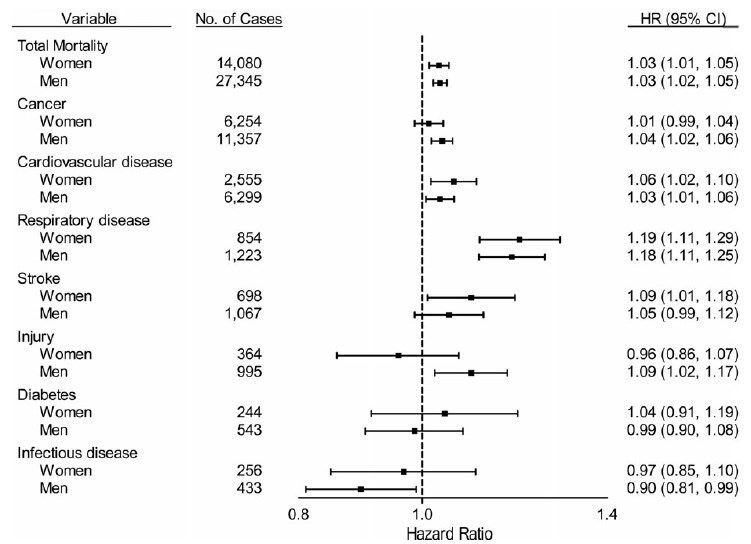Air conditioning has not totally canceled the latitude effective in the US yet
Prospective Study of Ultraviolet Radiation Exposure and Mortality Risk in the United States
Am. J. Epidemiol. (2013) 178 (4): 521-533. doi: 10.1093/aje/kws589
Shih-Wen Lin*, David C. Wheeler, Yikyung Park, Michael Spriggs, Albert R. Hollenbeck, D. Michal Freedman and Christian C. Abnet
↵*Correspondence to Dr. Shih-Wen Lin, Nutritional Epidemiology Branch, Division of Cancer Epidemiology and Genetics, National Cancer Institute, 9609 Medical Center Drive, 6E404, MSC9768, Bethesda, MD 20892 (e-mail: [email protected]).
Geographic variations in mortality rate in the United States could be due to several hypothesized factors, one of which is exposure to solar ultraviolet radiation (UVR). Limited evidence from previous prospective studies has been inconclusive. The association between ambient residential UVR exposure and total and cause-specific mortality risks in a regionally diverse cohort (346,615 white, non-Hispanic subjects, 50–71 years of age, in the National Institutes of Health (NIH)–AARP Diet and Health Study) was assessed, with accounting for individual-level confounders. UVR exposure (averaged for 1978–1993 and 1996–2005) from NASA's Total Ozone Mapping Spectrometer was linked to the US Census Bureau 2000 census tract of participants' baseline residence. Multivariate-adjusted Cox proportional-hazards models were used to estimate hazard ratios and 95% confidence intervals. Over 12 years, UVR exposure was associated with total deaths (n = 41,425; hazard ratio for highest vs. lowest quartiles (HRQ4 vs. Q1) =
1.06, 95% confidence interval (CI): 1.03, 1.09; Ptrend < 0.001) and with deaths (all Ptrend < 0.05)
due to cancer (HRQ4 vs. Q1 = 1.06, 95% CI: 1.02, 1.11),
cardiovascular disease (HRQ4 vs. Q1 = 1.06, 95% CI: 1.00, 1.12),
respiratory disease (HRQ4 vs. Q1 = 1.37, 95% CI: 1.21, 1.55), and
stroke (HRQ4 vs. Q1 = 1.16, 95% CI: 1.01, 1.33)
but not with deaths due to injury, diabetes, or infectious disease.
These results suggest that UVR exposure might not be beneficial for longevity.

-–
Difference in death rate highest to lowest UV:
Summary by Vitamin D Life
||Total | 6 %
Cancer | 6%
Cardiovacsular | 6%
Respiratory |37%
Stroke |16%||
PDF is attached at the bottom of this page
See also Vitamin D Life
Low levels of vitamin D associated with all cause mortality – Oct 2012
Death rate 2X higher at age 60 if low vitamin D - 180,000 in Israel May 2012
Sunny vacations are one of the ways to raise vitamin D levels – June 2013 the study on this page ignores vacations, moving around the us during the lifetime, etc.
Whites were 2X more likely to be vitamin D deficient if wear long sleeves – Jan 2012
Some childhood cancer 30% less likely in parts of California with more UVB – April 2013
More UVB is associated with less cancer – study of 450,000 people – April 2012
Mortality and Cancer varies with latitude in France too – 2010
Perhaps Italians have air conditioning too: lower latitudes have less vitamin D – July 2013 which has the following
- The people living in the Southern portion of the US appear to be using air conditioning so much that the latitude affect of MS reversed by the middle of the century

